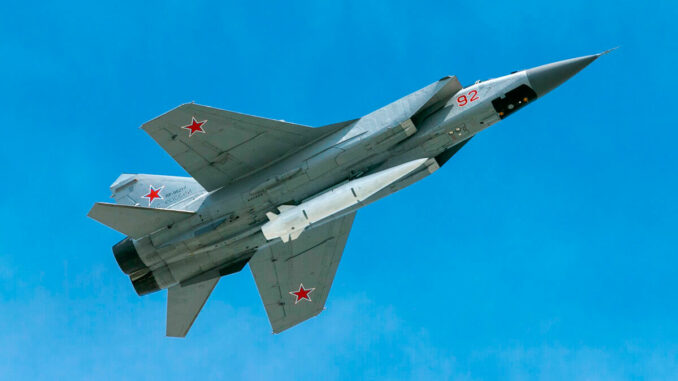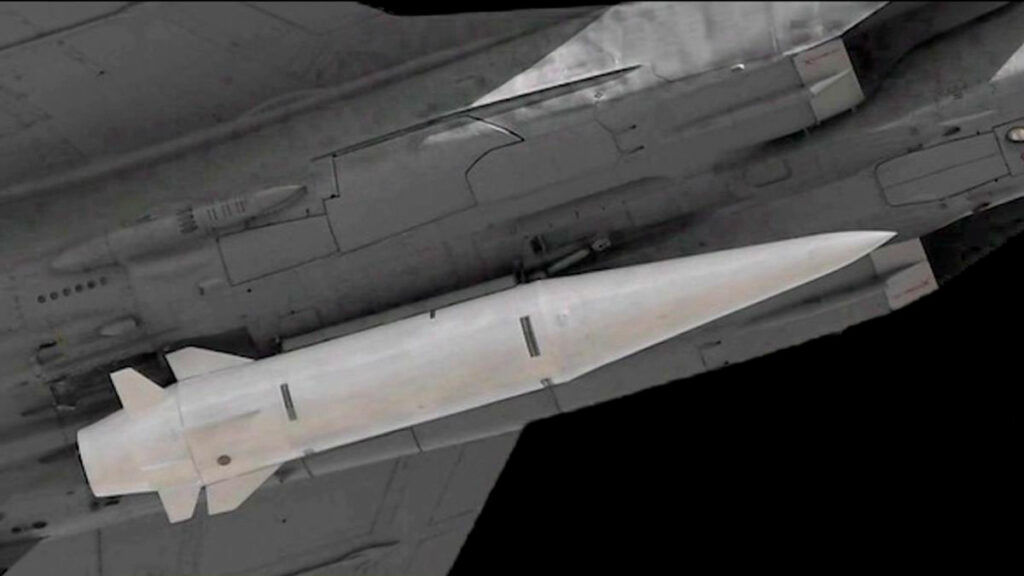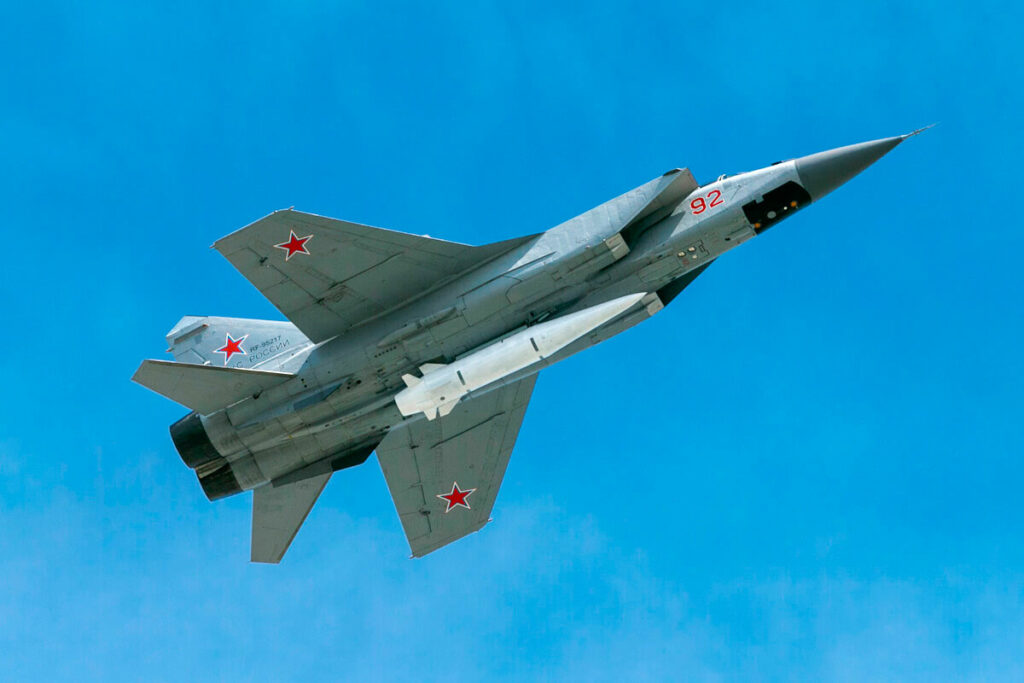
Is the Kinzhal missile truly hypersonic or a derivative of the Iskander? Technical, strategic, and documentary analysis of a Russian hybrid system.
Technical origins: Is the Kinzhal a modified Iskander?
The Kh-47M2 Kinzhal missile, officially unveiled by Russia in 2018, is frequently described as an air-launched version of the Iskander-M (9K720) ballistic missile. This claim is based on structural similarities and the admission of some Russian officials. However, there are several substantial differences between the two systems, which partially cast doubt on the idea that it is simply a clone.
The Iskander-M is a short-range, ground-to-ground ballistic missile deployed from a mobile ground launcher. It is approximately 7.3 meters long, weighs nearly 3,800 kg at launch, and reaches estimated speeds of Mach 6 to Mach 7. It has a range of approximately 500 km, with a warhead weighing 480 to 700 kg, which can be conventional or nuclear. It uses a single-stage solid fuel engine, with a semi-ballistic flight phase and terminal maneuvering capabilities to evade anti-missile systems.
The Kinzhal, although similar in appearance, has been adapted for launch from aircraft, mainly the MiG-31K, which has been modified to carry a belly payload of nearly 4,500 kg. The airborne version of the missile has a propulsion system derived from that of the Iskander, but modified for in-flight separation. Thanks to the aircraft’s initial speed (Mach 2.3 at 15,000 meters), the Kinzhal benefits from reduced thrust requirements for launch and reaches an estimated terminal speed of Mach 10, with a range of 1,500 to 2,000 km, depending on altitude and launch speed.
The inertial guidance system has also been redesigned to adapt to launch from a mobile air platform, with the possibility of integrating a corrected GLONASS system. The warhead remains the same, but the flight profile has changed: the Kinzhal now spends more time in the atmosphere, which alters its radar signature and maneuverability. The missile is therefore not simply an Iskander dropped from an aircraft, but a hybrid adaptation combining existing structures and airborne innovations.

What is a hypersonic missile according to current standards?
The term “hypersonic” refers to any object flying at a speed greater than Mach 5, or approximately 6,174 km/h in the Earth’s atmosphere at sea level. This threshold definition is shared by most technical and military organizations, including NATO. However, this speed alone is not sufficient to classify a missile as hypersonic in the strategic sense of the term. The nature of the propulsion, the flight profile, and the maneuverability in the atmospheric phase must also be taken into account.
There are three main families of hypersonic systems:
- Conventional ballistic missiles (such as the Iskander): these reach hypersonic speeds via a ballistic trajectory after a short propulsion phase. They generally fly along a predefined curve, with limited maneuverability, making them vulnerable to interception in the terminal phase.
- Hypersonic gliders (HGVs): these vehicles are launched by a rocket into the upper atmosphere, where they detach and glide at very high speeds while performing complex maneuvers. This is the case with the Russian Avangard system.
- Hypersonic cruise missiles: powered from start to finish by supersonic combustion ramjet engines (scramjets), they fly at low altitude and high speed while remaining highly maneuverable. The Russian Zircon missile falls into this category.
The Kinzhal does not fully correspond to any of these categories. It does reach speeds in excess of Mach 5, but its propulsion is only active in the initial phase. The missile follows a largely ballistic trajectory, although it is capable of maneuvering in the atmosphere at high speeds.
NATO standards tend to reserve the term “hypersonic” for vehicles that maneuver at high speeds in the atmosphere for sustained periods. Russia, on the other hand, classifies any system exceeding Mach 5 as “hypersonic,” without requiring scramjet propulsion or prolonged atmospheric flight. This semantic discrepancy fuels strategic confusion and reinforces ambiguity in military communications.
Flight profile analysis: does the Kinzhal maneuver in the hypersonic phase?
The Kinzhal and Iskander-M share a common architecture, but their flight profiles differ significantly due to their launch vehicles. The Iskander, fired from a ground-based launcher, follows a semi-lofted ballistic trajectory, i.e., a modified parabola with atmospheric maneuvering phases. Its terminal velocity is between Mach 6 and Mach 7, with end-of-flight maneuvers designed to evade missile defense systems. These maneuvers are limited in amplitude and duration, but sufficient to complicate trajectory calculations by an interceptor.
The Kinzhal, launched from a high-altitude, high-speed MiG-31K, benefits from a much more favorable initial momentum. After launch, its solid-fuel engine ignites and the missile quickly climbs to an estimated speed of between Mach 8 and Mach 10. Unlike a conventional ballistic missile, it follows a near-flat trajectory, remaining longer in the upper atmosphere, between 30 and 50 kilometers, before diving toward its target.
In its terminal phase, the Kinzhal is said to be capable of high-speed lateral maneuvers, which would distinguish it from strict ballistic profiles. However, no independent source has been able to confirm the extent of these maneuvers. The videos released by the Russian authorities do not allow for precise measurement of the missile’s agility at Mach 10 in a dense atmosphere, where thermal and aerodynamic constraints are extreme.
Western detection systems were unable to observe complex trajectories during strikes in Ukraine, particularly in 2023. Some Kinzhal missiles were even intercepted by Patriot PAC-3 batteries, suggesting a predictable signature in the terminal phase, unlike hypersonic gliders. These elements tend to qualify the idea that the Kinzhal actively maneuvers at hypersonic speeds throughout its trajectory.
Revolutionary weapon or strategic communication tool?
The Kinzhal occupies a central place in Russian strategic doctrine as a dual-role weapon: operational and symbolic. Militarily, it is designed to rapidly strike long-range strategic targets while circumventing Western missile defense systems. Its reported speed, maneuverability in the terminal phase, and launch from a mobile air platform make it an adaptable vehicle for targeting command posts, air bases, or advanced radar systems.
The Kinzhal is part of Russia’s “active defense” strategy, which seeks to neutralize NATO’s projection capabilities. It can be equipped with conventional or nuclear warheads, which reinforces its deterrent effect, particularly in Eastern Europe. Its estimated range of 1,500 to 2,000 km allows it to strike deep targets without entering enemy airspace.
Since its presentation by Vladimir Putin in March 2018, the Kinzhal has been at the center of aggressive military communications. The first tests were widely publicized, and official videos emphasized its speed and “uninterceptable” nature. In Ukraine, it has been used several times, notably in 2022 and 2023, to strike critical infrastructure. Although some missiles reached their targets, others were intercepted, calling into question the image of invulnerability conveyed by propaganda.
The term “hypersonic” plays a key role in information warfare. By using it repeatedly, Moscow seeks to impress its adversaries and strengthen its technological posture, even if the Kinzhal does not meet the strict criteria of a new-generation hypersonic missile. This semantic inflation aims to create a climate of uncertainty, which is essential in an asymmetric deterrence strategy.

What we know (and what we don’t know): limitations of available information
Analysis of the Kinzhal missile is largely constrained by the lack of independent, verifiable data. The information available comes mainly from official Russian sources or demonstration videos. No direct access to flight telemetry, detailed technical specifications or guidance systems has been provided by neutral bodies. This makes it very difficult to accurately assess its actual performance.
In combat situations, particularly in Ukraine, empirical observations have been made, but these remain fragmentary. Some strikes have been confirmed by open source analysts through the examination of satellite images or videos, but without direct measurement of speed or complete trajectory. In May 2023, several Kinzhal missiles were intercepted by the Patriot PAC-3 system, which surprised many observers. This suggests that the missile is not as elusive as Russian official communications claim.
The technical conditions for observation are also problematic. The Kinzhal’s high speed, high-altitude atmospheric trajectory, and possible use of electronic countermeasures complicate radar tracking. Furthermore, Western sensors, even if they have advanced capabilities, do not publicly share their real-time analysis data. Estimates of speed, altitude, and maneuver phase therefore remain subject to uncertainty.
In the absence of precise documentation, the Kinzhal remains a hybrid object. It combines elements from an existing ballistic missile with an airborne launch platform, giving it real operational advantages without falling into the category of breakthrough hypersonic weapons. The inability to clearly distinguish between technological innovation and strategic adaptation fuels the deliberate ambiguity surrounding this system, making it as much a political tool as a military one.